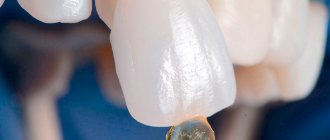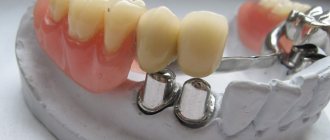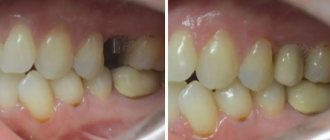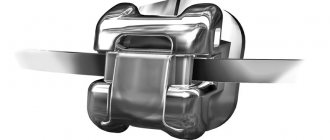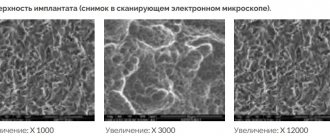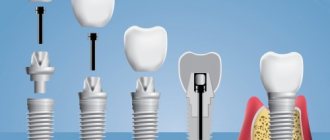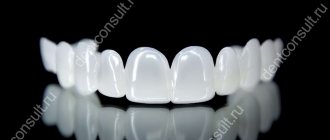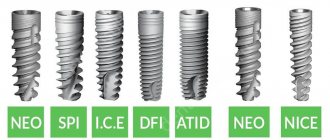Componeers are ready-made linings made of nanohybrid composite, durable, lightweight and porous. Unlike individually made veneers, componeer is made according to a sample, resulting in a relatively low cost of the product. By agreeing to the installation of composites, a person gains the opportunity to quickly change his appearance - to cover with a composite, like a shield, uneven tooth surfaces, cracked enamel and other imperfections in the smile area.
Nowadays, the range of compositors presented in dentists’ offices is extremely diverse. Therefore, for any patient, the doctor will select a product that matches the color and shape of natural teeth.
When to use componeer
Componers are used in cases where the patient wants to correct dental defects with veneers. Like other products of a similar nature, componers perform similar functions:
- Mask fillings on the front part of the tooth;
- Eliminate diastemas and interdental gaps, improving the aesthetics of the smile;
- They hide dark, spotted teeth under their surface;
- Restore chipped enamel and worn-out dental units;
- They hide the imperfections of crooked teeth, set at an angle or creeping onto neighboring ones;
- Replaces the teeth whitening procedure.
Componers successfully combine the advantages of two techniques – direct composite veneering and installation of ceramic indirect onlays. A ready-made template is taken and glued to the tooth in the dentist’s office. As a result, the patient's time and money are saved.
An innovative patented veneering method was the appearance in dental practice of Luxneers veneers - veneers without preparation for the front teeth. With them it is possible to correct any imperfections in the color, shape and some degree of curvature of the teeth without drilling, anesthesia and pain.
Works of our specialists
Result of dental restoration
Patient: girl, 26 years old.
Cervical caries, dental dystopia, imperfect restoration on the 11th tooth were diagnosed. The restoration on the 11th tooth was replaced, the 22nd tooth was ground, and a set of ceramic duo veneers from the 14th to 24th tooth was fixed.
Patient: 32 years old.
A dental anomaly was diagnosed, a reluctance to be treated with braces, complaints about dissatisfaction with the color and composite restorations of 12-22 teeth. Laser whitening was performed on teeth 15, 14, 13, 23, 24, 25, as well as the lower dentition. Laser correction of the gingival margin was carried out with a CO2 laser - this part of the work was performed by cosmetologist-dermatologist E.A. Kosenko. The composite restorations were removed and a duo of veneers were placed on teeth 12, 11, 21, 22.
Patient: girl 20 years old
She complained about unsatisfactory results after wearing braces, different heights of teeth in the cervical area. Caries was diagnosed on teeth 12 and 13. First of all, laser whitening was carried out, and the gingival margin was corrected using a CO2 laser (the work on laser correction of the gums and increasing its biological height was performed by cosmetologist-dermatologist E.A. Kosenko). The 12th and 13th teeth were ground. After that, restoration was performed using a duo of veneers from 13 to 23 teeth without grinding.
Patient: girl 25 years old.
Repeated endodontic work was carried out on teeth 21 and 22, and fiberglass was installed on teeth 21 and 22. A composite system from Coltene/Whaledent AG (Switzerland) was installed for teeth 12, 11, 21, 22. The complex of works was completed in 1 visit.
Patient: 48 years old woman
She complained of dissatisfaction with the color of the enamel and the inclination of the teeth inward. Selective grinding was done, followed by setting of composites from 13 to 23 teeth. Second visit 14, 15, 24, 25.
Patient: 45 year old woman.
Cervical caries, gum recession, dystopia of the 12th tooth were diagnosed. Laser whitening was performed, after which the 12th tooth was polished. Duo veneers were installed from the 13th to 24th teeth.
How to install componers
Installation of the nanocomposite compositor occurs in stages:
- The doctor, together with the patient, decides on the color of the plate.
- The dentist applies a special gel called try-on gel to the veneer. It is flimsy and only serves to demonstrate what the template looks like in a row of teeth. If the selected color does not match, the template is removed and the gel is washed off. The procedure is repeated with a sample of a new shade.
- If the characteristics satisfy the doctor and the patient, the gel is replaced with medical cement identical in color, which strengthens the composite on the tooth.
- The shape of the componer is subject to correction. It remains possible to correct the color with a special color scheme.
Indirect porcelain veneers involve multiple visits to the office, first to take impressions, then to try them on, and finally to place lumineers, or porcelain veneers, on your teeth. Therefore, the process of acquiring a beautiful smile lasts for weeks, sometimes reaching one and a half months.
At the same time, when choosing an indirect veneering technology, the patient is deprived of the opportunity to influence the choice of plate shade or control the work of technicians in the laboratory. The selection of compositors and subsequent installation are advantageously reduced due to the availability of ready-made molds and the absence of the need to use the labor of laboratory technicians and the operation of expensive equipment.
Which ones are better
It is impossible to say unequivocally that ceramic veneers are better. They are stronger, more durable, and more comfortable. The significant difference in price between composites and veneers sometimes forces one to choose a tooth covering made of a composite material. They can be replaced as needed to benefit your own budget.
On a note!
Which dental coating to choose depends on the initial condition of the incisors and the patient’s wishes.
Ceramic veneers are recommended in the following cases:
- the need for long-term use of pads;
- the presence of serious visual defects – cracks, chips, dark areas, crooked teeth;
- budget allows;
- There is time to wait for the veneer to be made.
Componers are recommended for patients if:
- it is necessary to urgently correct the visual defect;
- budget is limited;
- need for temporary use.
What is the difference between preparing teeth for restoration with veneers and composites?
The general stage of preparation for installing both types of plates on the patient’s teeth includes thorough sanitation of the oral cavity. Professional cleaning is carried out, plaque and stone are removed. If necessary, caries is treated.
The differences are few, but they are large in character and perception by the patient. For example, gluing composites most often does not require preliminary grinding of a living tooth. In exceptional cases, a minimal area sparing effect is performed.
Of the orthopedic veneers made in dental laboratories on machines, only Luxneers veneers and American lumineers do not require turning.
When applying plates to the surfaces of several dental units, the process begins with the front central teeth in the row. The final result depends on the correct execution, so the action takes 1.5 - 2 hours. The more templates are expected to be placed, the more time the patient will spend in the dental chair, but the procedure is always completed in one clinic visit.
To install ceramic veneers (not luxeers, lumineers), it is necessary to first cut down part of the enamel. The tooth is prepared from all sides, including the cervical part, lateral surfaces, cutting edge and back side. Subsequently, it is no longer possible to remove the veneer, since the organ is prepared as much as possible.
The patient will have to visit the doctor several times; the procedure includes both a clinical and laboratory stage. If the dentistry is located in another city, you will have to add transportation costs to the cost of treatment.
Is there a visual difference
A special scale helps you choose the color of ceramic veneers. The shade of the composite is selected in the same way. If it is chosen correctly, then there is practically no visual difference.
You can find reviews from patients who say that componeers look less natural. However, this indicator largely depends on the professionalism of the clinic, the material used and the experience of the dentist. Therefore, when choosing a medical institution and a doctor, you should carefully study the reviews and study the differences in the photo.
Disadvantages of Composers
The technology has an extremely small number of disadvantages, which allows patients to often resort to installing ready-made plates.
- For example, since 2011, the date of the introduction of veneers into dental practice, sufficient material has not yet been accumulated to talk about the durability limits of these veneers. However, the expected lifespan is 5-10 years.
- Componers are not intended to correct dental deficiencies. They can only cover up unwanted small deformations.
- If compositors are installed on the upper row of teeth and completely cover the smile area, it is often necessary to use whitening of the lower teeth to achieve a harmonious appearance.
- Componers do not always fit tightly to the teeth and caries forms underneath them, followed by tooth destruction.
Preparing to fix the overlays
It is imperative to prepare for restoration. If there are carious cavities, they will need to be filled. If there have been fillings in the smile area for a long time, they may need to be replaced with new ones. Another important condition is to undergo the procedure of Prof. hygiene. Before installing onlays, you need to remove plaque and tartar.
Before the installation procedure, a prof. dental hygiene
Benefits of installing componeer
Often people are slightly intimidated by the fact that a componer is a template form. Each person is unique, and the patient is worried that the new artificial tooth will be too different from the others, clearly demonstrating its own unnaturalness.
However, a competent dentist will dispel the patient’s fears when he voices a list of the advantages of the technique:
- The products are presented in a variety of options. You can choose the shape and color, which makes it possible to select componeers individually.
- There is aesthetics that meets high demands. Teeth corrected with onlays look natural and do not differ from natural ones. At the same time, they are noticeably inferior in aesthetic beauty to Hollywood veneers.
- It is possible to change the color and shape of teeth. If you are unwilling or unable to perform whitening, it is easy to get a snow-white smile by installing composites.
- The reasonable cost of template veneers makes them competitive in comparison with expensive ultraneers and lumineers, and the speed of installation often becomes decisive in the choice of correction method.
- The price of composite veneers is slightly higher than the installation of composite veneers. But the latter require regular polishing, and nanocomposite veneers look like new even after years.
- Veneers cannot be repaired, only replacement is allowed. Componeers can be repaired by partial chipping right in the patient's mouth.
- The records do not require sophisticated care. Enough with the usual hygiene. Moreover, the onlay reduces the risk of caries by preventing the accumulation of bacteria on the front wall of the tooth.
Features of care and cost
Patients who have had a componeer installed should completely reconsider not only their oral hygiene practices, but their entire lifestyle. There are no dietary restrictions as such, but it is recommended to avoid eating seeds and very hard foods. You should also get rid of habits that are harmful to your teeth, such as cracking nuts or opening bottles.
To perform oral hygiene, you need to use not only a brush, but also dental floss and an irrigator. It is important to undergo periodic dental checkups.
Componers are the most budget option. Their price for 1 piece varies from 7 to 12 thousand rubles. For comparison, the cost of a veneer is 20-25 thousand rubles, and the price of an original lumineer can reach 60 thousand rubles. The price of services of this kind also depends on the status of the clinic, the qualifications of the specialist and the materials used.
The cost of direct compositors may differ from the amount for indirect ones. This is explained by the fact that 2 people take part in the manufacture and installation of the latter. The price of componers in Moscow may be higher than in the regions.
